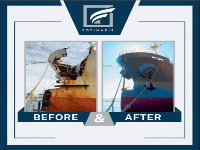Russia Reports Progress on Nuclear-Powered Submarine LNG Carriers
Russia has confirmed progress in its ongoing project to design nuclear-powered, LNG-carrying submarines for gas exports along the Northern Sea Route (NSR). The project would put it in the vanguard for a nuclear merchant ship revival - and in a class of its own for commercial submarine transport. In an interview with the state-owned news agency Tass, Russian Transport Minister Roman Starovoit said that underwater gas carriers may soon be launched on the NSR, although he did not provide a timeline.
“We are discussing underwater gas carriers that will operate on this route. The Kurchatov Institute is developing the project, and it is quite possible that the (submarine gas carriers) will soon appear on the route,” said Starovoit.
Details of the project were first publicized at an event in St. Petersburg last year. Mikhail Kovalchuk, Director of the Kurchatov Institute, presented on the submarine project, claiming that it is a viable alternative to traditional gas carriers.
Governor General:
Russia has developed a model of a unique nuclear-powered underwater gas carrier
The Kurchatov Institute has developed a model of a nuclear-powered submarine for transporting liquefied natural gas (LNG) along the Northern Sea Route (NSR) without breaking the… pic.twitter.com/tb89QFkGnw
— East_Calling (@East_Calling) October 14, 2024
With Russia developing its Arctic LNG projects, conventional gas carriers are limited for year-round navigation without icebreaker escort. If successful, the submarines could revolutionize Russia’s gas transport in the Arctic, at a time when sanctions on the country have slowed construction of icebreakers.
At a technology forum early this year, Putin celebrated the concept, describing it as a feasible future for Arctic LNG transport. “I first heard about this innovative idea from Mikhail Kovalchuk a couple of years ago. Although initially skeptical, it turns out that Gazprom and Novatek believe it is quite feasible, profitable and efficient,” stated Putin.
Kurchatov Institute, Russia’s leading nuclear research facility, is supporting with the technical design of the project. The submarine is expected to be 360 meters long, width of about 70 meters and height of 30 meters. It will have a draft of 12-13 meters and reach speeds of up to 17 knots. Further, the submarine will be equipped with three RITM-200 nuclear reactors with a total propulsion capacity of 90 MW. The submarines will also have capacity for around 180,000 tons of LNG.
But some analysts doubt whether Russia is able to deliver on this project, citing capacity constraints to design and source parts for a nuclear submarine platform. Indeed, western sanctions on Russia have also affected investments needed in the NSR. For the route to be competitive, massive upgrades for Arctic ports and related infrastructure are needed.
Chinese firms which have expressed interest in using the route have backed down, possibly due to concerns over secondary sanctions. For instance, China state-owned shipping company COSCO has suspended operations along the NSR, leaving only a few privately-owned firms to use the route. But Chinese support for NSR is likely to increase with the recent establishment of a China-Russia commission on NSR development.
Content Original Link:
" target="_blank">


















































